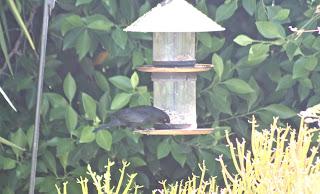I was curious as to why a pair of Canada Geese (Branta canadensis) had not left with the rest of the flock. I watched and last week saw three babies accompanying the parents around a pond on the golf course. Ahhh, mystery solved.
Then, today, I saw two separate families of Canada Geese, one with three new goslings, and one with two. Now the babies are about half the size of their parents and following them around. It was fun to watch the little ones mimicking their parents. When the adults dipped their bills into the pond, so would the babies. I will keep an eye on the new arrivals and keep track of their progress.



I also noticed something while taking the family photos. One of the adults, the female I think, has a narrow white ring around the base of the neck and was somewhat smaller than the other. I thought it was an Aleutian, but the bill seems too long and the ring on my bird was too narrow according the picture in Sibley's guide. I thought it might possibly be a Cackling Goose, but the head was not round and the bill too long on my bird, although the neck ring is narrow and more subtle on the Sibley guide picture like my bird. I am wondering if it is just a variation of the more Common Canada Goose, with a necklace, or a hybrid Aleutian and Common subspecies? I am open to any suggestions, please email me at philparker02@gmail.com.

Note the subtle ring around the base of the neck of this bird. It is hard to show here, but this is somewhat smaller than its' partner.

This is the partner and clearly a Common Canada Goose, (Branta canadensis), for comparison.
While following and watching the geese, I saw a family of Mallards, (Anas platryhnchos), swimming in the pond. It was great watching the little squadron moving in a controlled manner around the edge of the pond.

I also saw what I believe to be a Spotted Sandpiper, (Actitis macularia) working its way around the edge of the pond. This one had the particular bobbing behavior I read about. This means the bird probed the mud along the waters edge, then looked like it was going to sit down, then changed it's mind and stood up, then sit, then stand, bobbing up and down three or four times. It would then walk along probing the mud, then bob up and down three or four times again.

I saw this bird while photographing the geese, and when I walked toward it saw it disappear on the near bank of the pond. I walked to where I saw it vanish, and couldn't find it. Then, within a foot of my, well...foot, the bird flushed and flew to the far bank and went about it's business as if nothing had happened.
I saw a couple other birds while wandering around the golf course, one was an American Widgeon, (Anas americana), sitting with a pair of Mallards. I don't know why this one did not leave with the flock of several hundred that come each year and leave in April sometime. Any ideas?

Also, skimming the top of the pond for bugs was a Kingbird, (Tyrannus verticals).

You might be a birdnerd if...you spend a beautiful Sunday morning walking the golf course taking family photos of the birds who have taken residence there.









